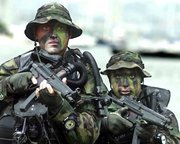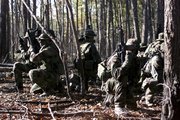U.S. Navy SEALs
|
|
Official force name
U.S. Navy SEALs
SEALs
Nickname
Frogmen
Branch
Chain of Command
U.S. Navy Special Warfare Command
NAVSPECWARCOM Although Controlled by USSOCOM
Description
Extremely versatile Sea, Air, or Land Special Operations/Counter-terrorist Force trained for Basic Underwater Demolition (BUD), direct action, couter-terrorism,counter-drug operations, raids, kidnapping, and gathering intelligence.
Readiness
Each team can deploy anywhere in the world with 4 hours notice by sea, air, or land.
Specializations
Conducting Airborne operations, conducting direct action operations, conducting raids, counter-terrorism, hydographic recoinnasance, infiltrating and exfiltrating by sea, air or land, intelligence, recovery of personnel and special equipment, support of general purpose forces (GPF), underwater demolition.
Headquarters
Insertion date
Reason of creation
U.S. Navy need for warfare by other means than conventional.
The United States Navy SEALs (Sea-Air-Land) handle Special Operations/Counter-Terrorism missions from the sea, air and land for the United States Navy. Their missions include reconnaissance, counter-terrorism, clandestine operations, and unconventional and counterguerilla warfare.
Each SEAL team specializes in an Area of Operation (AO), such as jungle, arctic, woodland or desert terrain. Special tactics, techniques and equipment apply to each AO from SEAL Delivery Vehicles and highspeed gunner boats to advanced SCUBA gear and other sophisticated equipment.
| Contents |
Force fact file
The U.S. Navy SEALs are considered to be one of the world's premier Special Operations and Counter-Terrorism Forces. Though technically specializing in maritime insertion, the SEALs are inserted by sea, air or land, hence the acronym. From the jungles of Vietnam, to the shores of Panama, or to the sands of Iraq, SEALs have proven to be a fearsome and effective Special Operations/Counter-Terrorist Unit.
Historically, they can trace their history to the first group of volunteers selected from the Naval Construction Battalions (Seabees) in the spring of 1943. These volunteers were organized into special teams called ‘Navy Combat Demolition Units’ (NCDUs). The units were tasked with reconnoitering and clearing beach obstacles for troops going ashore during amphibious landings, and evolved into Combat Swimmer Reconnaissance Units.
The NCDUs distinguished themselves during World War II in both the Atlantic and Pacific theaters. In 1947, the Navy organized its first underwater offensive strike units. During the Korean Conflict, these Underwater Demolition Teams (UDTs) took part in the landing at Inchon as well as other missions including demolition raids on bridges and tunnels accessible from the water. They also conducted limited minesweeping operations in harbors and rivers.
During the 1960s, each branch of the armed forces formed its own counterinsurgency force. The Navy used UDT personnel to form multiple units called SEAL teams. January 1962 marked the commissioning of SEAL Team ONE in the Pacific Fleet and SEAL Team TWO in the Atlantic Fleet. These teams were developed to conduct unconventional warfare, counter-guerrilla warfare and clandestine operations in both blue water and brown water environments.
Those qualifying to become Navy SEALS are authorized to wear and display the Special Warfare Badge, also known as the SEAL Trident. This badge, commonly called the "trident" or "Budweiser" (for its resemblance to the Budweiser Eagle), serves as the insignia for the SEALs as a whole and is the largest and most recognizable warfare pin in the United States Navy.
US_Navy_SEALs_SEAL_jumps_over_side_boat.jpg
Concurrently, Naval Operations Support Groups were formed to aid UDTs, SEALs, and two other unique units —Boat Support and Beach Jumpers— in administration, planning, research, and development. During the Vietnam War, UDTs performed reconnaissance missions and SEALs carried out numerous offensive operations.
In 1967, the Naval Operations Support Groups were renamed ‘Naval Special Warfare Groups’ (NSWGs) as involvement increased in special operations.
In 1983, existing UDTs were re-designated as ‘SEAL teams’ or ‘SEAL Delivery Vehicle Teams’ and the requirement for hydrographic reconnaissance and underwater demolition became ‘SEAL missions’.
The Naval Special Warfare Command was commissioned April 16, 1987, at the Naval Amphibious Base Coronado in San Diego, California. Its mission is to prepare Naval Special Warfare forces to carry out their assigned missions and to develop special operations strategy, doctrine, and tactics.
Navy SEAL Teams and Structure
A Navy SEAL Platoon consists of 16 men per platoon. This can be easily split into four 4-man squads for operational purposes. The actual size of each SEAL "Team" is larger, ranging between eight to ten Boat Teams per SEAL Team.
As of this writing, there are nine confirmed Navy SEAL Teams. The original SEAL Teams in the Vietnam were separated between East Coast (Team One) and West Coast (Team Two) SEALs. The "Official" current SEAL Team deployments are from Teams 1 through 5, and 8: The Teams now deploy as Naval Special Warfare Squadrons. Any Team is able to deploy anywhere in the world.
SEAL Team ONE is based in Coronado, CA. Commanded by a Navy Commander (O-5), it has eight operational SEAL platoons and a headquarters element. SEAL Team ONEs previous geographic area of concentration was Southeast Asia.
SEAL Team TWO is based at Little Creek, VA. Commanded by a Navy Commander (O-5), it has eight operational platoons and a headquarters element. SEAL Team TWOs previous geographic area of concentration is Europe, and was the only SEAL team with an arctic warfare capability.
SEAL Team THREE is based in Coronado, CA. Commanded by a Navy Commander (O-5), it has eight operational platoons and a headquarters element. SEAL Team THREEs previous geographic area of concentration was Southwest Asia.
SEAL Team FOUR is based at Little Creek, VA. Commanded by a Navy Commander (O-5), it has ten operational platoons and a headquarters element. SEAL Team FOURs previous geographic area of concentration was Central and South America. SEAL Team FOUR is the only SEAL Team with a viable standing language capability, Spanish.
SEAL Team FIVE is based in Coronado, CA. Commanded by a Navy Commander (O-5), it has eight operational platoons and a headquarters element. SEAL Team FIVEs previous geographic area of concentration was the Northern Pacific.
SEAL Team SEVEN is based at Coronado, CA. Commanded by a Navy Commander (O-5), it has eight operational platoons and a headquarters element. SEAL Team SEVEN is one of the two newly commissioned SEAL TEAMS along with TEAM TEN.
SEAL Team EIGHT is based at Little Creek, VA. Commanded by a Navy Commander (O-5), it has eight operational platoons and a headquarters element. SEAL Team EIGHT's geographic area of concentration is the Caribbean, Africa, and the Mediterranean.
SEAL Team TEN is based at Little Creek, VA. Commanded by a Navy Commander (O-5), it has eight operational platoons and a headquarters element. SEAL Team TEN is one of two newly commission SEAL TEAMS along with TEAM SEVEN.
Many still believe in the existence of SEAL Team Six, which had a focus on counter-terrorism. This group was split from the SEALs and renamed DEVGRU, in a successful attempt to bring the team out of the public eye. It is now under the direct authority of Joint Special Operations Command. They bring in their operators from the SEALs and put them through further training to specialize them for CT operations.
Training
SEAL teams go through some of the toughest military training in the world. Basic Underwater Demolition/SEAL (BUD/S) training is conducted at the Naval Special Warfare Center in Coronado (San Diego, CA) and lasts 26 weeks.
BUD/S consists of a five-week "Indoctrination Course," followed by three phases, covering physical conditioning (eight weeks), diving (eight weeks), and land warfare (nine weeks) respectively. Officer and enlisted personnel go through the same training program, and it is designed to develop and test their stamina, leadership and ability to work as a team.
BUD/S is known for Hell Week, a period of several days during First Phase when SEAL trainees are deprived of sleep (they get less than four hours the entire week), and made to do strenuous physical tasks far more difficult than those of any other week during the training cycle. Trainees are almost always "wet and sandy" and develop what is known as the Hell Week shuffle, which is a way of walking that keeps salt-stained clothing away from chafed skin.
SEAL training and duty is voluntary. Many BUD/S students find that they do not have the desire to continue to endure the physical and mental strain of training, and subsequently Drop On Request, or DOR, from the course. Classes typically lose around 70-80% of their trainees - either due to DORs or injuries sustained during training. Most trainees are eliminated prior to Hell Week and far fewer "green shirts" (people that have made it through Hell Week wear green under-shirts instead of white) quit the BUD/S program.
After BUD/S, students must then attend Army Jump School for three weeks at Ft. Benning, GA - a relative breeze compared to BUD/S - in order to become airborne qualified. Upon completion of Jump School, they receive their Naval Special Warfare Classification (NEC) code. Finally, the last requirement before going to a team requires students to go through SEAL Qualification Training, or SQT, which is a 15 week course. This course is also conducted in and around the Naval Amphibious Base Coronado. After completion of SQT training, students are then considered SEALs and are awarded the SEAL pin, or Trident.
As of late, particularly in the wake of the 9/11 Attacks, the United States Marine Corps has "lent out" Marines from Force Recon and Marine recon battalions to the SEALs for special training as Marine SEALs.
Famous Navy SEALs
- Thomas R. Norris - Vietnam-era SEAL, Medal of Honor Recipient.
- Scott Helvenston - graduated training at 17, becoming the youngest Navy SEAL in history.
- Rudy Boesch - competitor in the TV reality shows Survivor and Survivor: All-Stars.
- Richard Marcinko - founder of SEAL Team SIX and Red Cell, and NY Times bestseller Rogue Warrior co-author.
- Jesse Ventura - former Governor of Minnesota, actor, and former professional wrestler.
- Roy Boehm - First commanding officer of Seal Team Two.
- Dennis Chalker - plankowner of Seal Team Six and Red Cell
- Gary Jackson - president Blackwater USA, a private military contractor
- Chuck Pfarrer - SEAL Team SIX Operator, screenwriter with credits including The Jackal, Darkman, Red Planet, Virus, Hard Target, and Navy SEALS, and author of the NY Times bestseller Warrior Soul.
- William Shepherd - First commander of the International Space Station.
- Bob Kerrey - Democratic U.S. Senator from Nebraska (19892001), and President of New School University since 2005, Medal of Honor Recipient.
Movies
Games
Related topics
- Underwater Demolition Team
- U.S. Special Operations Command
- U.S. Special Operations Forces
- U.S. Marine Force Reconnaissance
- Red Cell
- Air Force Air Commandos
- Delta Force
- 22 Special Air Service (SAS) regiment
External links
- U.S. Navy SEALs Information Website (http://www.seal.navy.mil/seal) - official site.
- U.S. Naval Special Warfare Command Website (http://www.navsoc.navy.mil/seal) - official site.
- NavySEALs.com (http://www.navyseals.com)
- SpecialOperations.com: BUD/S Information Page (http://www.specialoperations.com/Schools/BUDS/)
- SpecialOperations.com: SEALs Information Page (http://www.specialoperations.com/Navy/SEALs/)
- SpecialOperations.com: SEALs Weapons (http://www.specialoperations.com/Navy/SEALs/Weapons.htm)
References
- US Navy. Navy Fact File: Navy SEALs (http://www.chinfo.navy.mil/navpalib/factfile/personnel/seals/seals.html). San Diego, California: Naval Special Warfare Command–Public Affairs Office. March 16, 1996.
"Encyclopedia of The Navy SEALs"



